Best Backspin Batting Tee Experiment For Youth Baseball, Slow Pitch, & Softball To Hit Launch Angle Line Drives | Swing Aid & Tools Trainer Reviews & Coupon Codes | STOP Son Hitting Too Many Weak Ground Balls To Shortstop!
Discover the best Backspin batting tee experiment for youth baseball, slow pitch, and fast pitch softball to hit more launch angle style line drives. Get swing Backspin Tee trainer reviews and coupon codes. Also learn how to STOP your son (or daughter) from hitting too many weak ground balls to shortstop.
Baseball Batting Cage Drills: Here’s A Quick Way To Hit Less Ground-balls
Question: Does The BackSpin Batting Tee Help Hitters Elevate The Ball?
In this baseball batting cage drills experiment using the Backspin batting tee, I wanted to use the Scientific Method to analyze what would happen to a hitter’s spray chart (ME!!) by taking:
- 100 swings using a conventional tee (ATEC Single Tuffy Tee), versus
- Taking another 100 swing using Taylor and Jarrett Gardner’s BackSpin batting tee.
I’ve done a couple posts promoting what Taylor and Jarrett are doing with the Backspin Tee because I really believe in their product and what it can do for young hitters in getting the batted ball off the ground. Whether we’re talking baseball, fast pitch softball, and slow pitch softball…
And to let you know, this experiment has been brewing in my head since the summer of 2015, but the stars just didn’t align…until NOW!
SCIENCE-BASED TRAINING:
Improve your hitting strategy dramatically by applying human movement principles.
Learn not only how and what to train but also the science behind the methods.
Background Research
Here are two baseball batting cage drills posts mentioned earlier, to give some background on the research for The Backspin batting tee:
- Baseball Batting Mechanics Risk Hiding In Your Batting Tee, and
- Batting Tee: The Ugly Truth Interview With Taylor Gardner.
Hypothesis
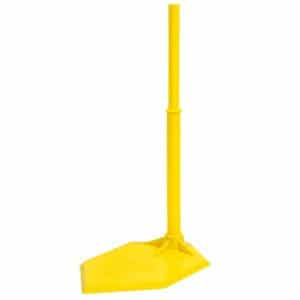
ATEC Tuffy Single Batting Tee photo courtesy: ATEC
Okay, so I cheated a little bit…
Before the OFFICIAL baseball batting cage drills swing experiment, I’ve been using the Backspin batting tee with my local hitters and the results have been positive.
And now, I’m making my Hypothesis official…
I think by using the Backspin batting tee, it will allow the hitter to cut down on ground-balls, and will empower them to get more effective at putting the ball in the air (line drives primarily).
In addition, I think that not only will the tee reduce a hitter’s ground-balls, but will contribute to above average line drive launch angles. Average line drives would be within the reach of a fielder.
Baseball Batting Cage Drills: Backspin Batting Tee Experiment
Equipment Used:
- Backspin Batting Tee,
- ATEC Single Tuffy Tee
,
- Flip Camera
,
- Baseballs, and
- 33-inch ProXR wood bat
Setup:

Closeup of the ‘inverted’ rubber cone that holds the baseball or softball. Photo courtesy: TheStartingLineupStore.com
- I had two of the same laminated images of the batting cage I was hitting in (Hitting Spray Chart images below).
- After each swing, I’d use a Sharpy pen to mark where the batted ball hit first (on the ground or the location on the batting cage netting), right after coming off the bat.
- All swings for the baseball batting cage drills experiment were taken off either a Backspin or ATEC Tuffy Single tee.
- I used the Backspin batting tee rubber cone for baseballs (they have one for softballs as well).
- I stayed as consistent as I could with keeping the ball height and depth the same for both tees.
- I used two yellow dimple ball markers to make my stance setup consistent…one was placed inside my back foot, close to the plate. The other was placed one bat’s length plus two baseballs in front of the back marker.
- The two tests in the baseball batting cage drills experiment were counter-balanced. Which consisted of eight blocks of 25-swings done in the following order ABBA BAAB. Hitting off the “Backspin Tee” was letter ‘A’, and off the “Conventional Tee” was letter ‘B’. 200 total swings were completed in the experiment, 100 per test. Counter-balancing helps remove the “getting tired” and “not being sufficiently warmed up” factors.
Data Collected (Hitting Spray Charts)
Backspin Batting Tee Spray Chart:

The Backspin tee spray chart is cleaner and resembles a bit of a tornado…
Conventional Tee Spray Chart:
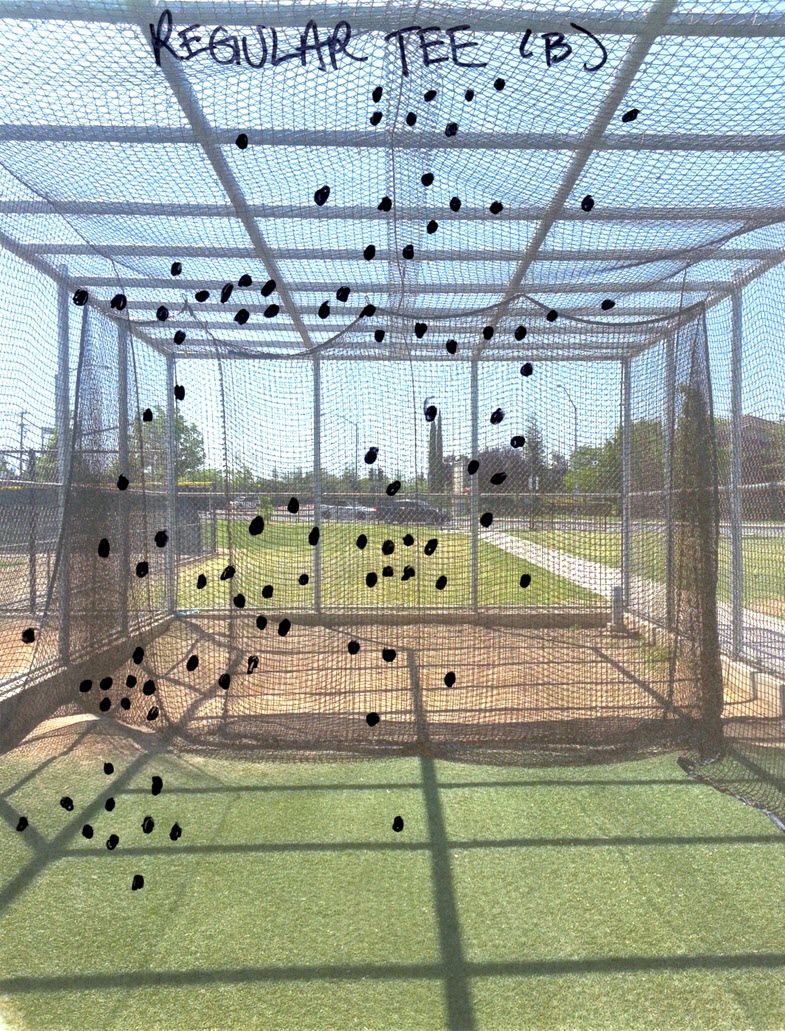
As you can see, the spray chart is a bit messy…
Data Analysis & Conclusion
- The Backspin batting tee spray chart looks much more tidy than the “regular” tee chart (the former looks like a tornado),
- You can see when using the conventional tee, I tended to pull the ball to left side of the cage.
- There are definitely a higher concentration of batted balls in the above average line drive spots (not within reach of the fielders), using the Backspin batting tee, and
- There were more balls hitting the ground or bottom of the cage when using a conventional tee.
Notes
- Addressing the excessive of pulled balls using the conventional tee, I thought maybe my tee was moving on me (getting too far out front). I even tried pushing the regular tee slightly deeper than the position I started it in for a couple swings, to counter this, but that wasn’t the issue.
- Now, here’s where it gets interesting…remember in the “Setup” section above, I hit on the Backspin Tee (‘A’) FIRST. I started to notice a pattern after switching tees…I didn’t have an issue getting the ball in the air with the Backspin tee, sometimes getting into the pop-fly territory. But what I found was after taking a Backspin tee 25-swing chunk, the first 10-15 swing launch angles off the conventional tee mimicked what I was getting with the Backspin Tee. As the conventional tee round approached the last 10-15 swings, the launch angle slowly creeped downwards into the average line drive arena. So when I repeated TWO conventional tee 25-swing chunks (the BB in the ABBA pattern), by the time I got to the end I was having a hard time getting the ball back up again using the conventional tee. And on the last BAAB 25-swing chunk pattern (last 100 swings), I noticed the same thing emerge.
- It was like the “magic” of the Backspin tee wore off after 10 swings into hitting on the conventional tee. My Hypothesis? If I took 100 STRAIGHT swings on a conventional tee, then 100 STRAIGHT on a Backspin tee, I’m willing to bet there would be WAY more ground-balls and average line drives using the conventional tee than I got in this baseball batting cage drills experiment.
- The other weird thing (in a good way) I noticed hitting off the Backspin batting tee, was that it trimmed up my spray chart (making it look more like a tornado rather than a cinder block). I rarely pulled the ball towards the left side of the cage hitting off the Backspin tee. And the ones I did pull that way, I’d be willing to bet it was after hitting off the conventional tee. CRAZY!
The Bottom Line?
Well, the baseball batting cage drills experiment data showed that not only did the Backspin tee elevate ball launch angles, but it also cleaned up horizontal outcomes. Meaning, I didn’t hit the ball to the left side of the cage as frequently when using the Backspin tee than I did with the conventional tee when the ball is located virtually in the same position every swing. Also, the “Backspin tee effect” lasted a good 10-15 swings into switching over and using the conventional tee!
- Fix Late Swings Fast: 2025 Pitch Recognition & See-Decide-Swing Training for Youth Baseball Power Hitters - October 6, 2025
- Safe Youth Weighted Bat Training: Proven Overload/Underload Drills to Increase Exit Velocity in Games Starting Tonight - September 29, 2025
- AI Coaching Course 2025: Youth Baseball & Softball Practice Plan + Off-Season & In-Season Workout Builder Fast - September 23, 2025


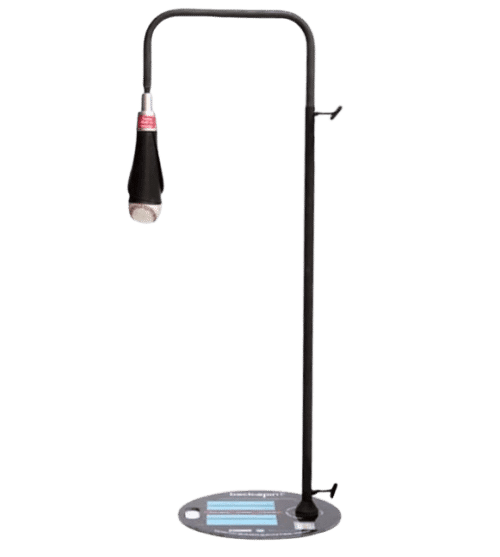
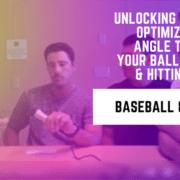
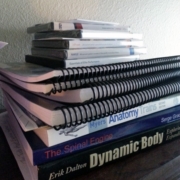
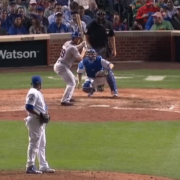

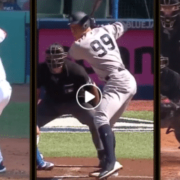






I’ve never used the backspin tee, but I started back in coaching probably 15 years after my college days when my son started playing. I had learned most everything I know from hitting initially from Doyle and FSU baseball camps coming up. When I got back into it, I worked with a fairly renown and successful college girls softball coach. His teaching was about shifting weight to the front side and hitting the bottom of the ball to get backspin. This encouraged an almost downward swing on the ball. Since I left baseball, I, like many, took up golf. In golf, backspin kills distance. The friction produced by high revolution backwards makes the ball sort of stand up instead of carry. In golf, you want a knuckle ball or a little bit of top spin off of a drive to get distance. If you don’t believe me, put some Carmex on the face of a driver and see how much more distance you get. That’s why the pros always wipe the sweat off of their nose or forehead before the wipe the face of their clubs, to get some oil on the surface and minimize spin. After a couple of years with the kids, I found the same in baseball and changed my teaching some. The line drives and fly balls the kids were hitting were hanging in the air too long and getting caught. I began making sure their hands started a little lower and their bat plane was on the same angle or even coming from underneath the ball plane a little. It produced a lot more hard line drives and got them rattling the fence a lot more over the next few years. I think backspin is great for someone that has a lot of strength and power, or on the short fences used in girls softball, but can produce a lot of easy fly ball outs in baseball. I am a mechanical engineer, so I understand the thought behind it, but if you take the extreme of backspin, it produces an infield pop-up, maybe even to the catcher. That’s why a catcher should turn around on a high pop-up. The extreme of top spin produces a high hopping ground ball. The trick is to be almost neutral, but if they fail on the side of topspin, they have a lot better odds of finding a hole or a defensive mistake to get on base. As they get older, they can modify their swing some in situations to hit either a fly ball for a sac fly or a ground ball on a hit and run. But when younger, getting their front foot down early enough and staying behind the ball with a good swing plane seems to me to produce better timing and more solid contact. I’ve watched video from most every great hitter and watch the great hitting teams we face, and all of their swings look almost identical when you look at the basics. Swing planes are from down to up, back palm stays up for a long time, weight shift is almost violent to the front foot (but settles back to the back foot after the swing because of the power angle), and they have a strong shoulder turn on their load. If they are a little late or early, it doesn’t matter, because the bat stays on plane with the ball for a long time so they have power to all fields.
I guess my point is you may want to do the same experiment in the field with a full defense and chart outs vs hits as well as without a defense and chart the total distance the balls travel.
You’re absolutely right Jimbo! We preach hit the bottom half of the ball, this gets the hitter to hit slightly below ‘knuckleball’. In one of the posts under “Background Research” you’ll see a good visual on this. However, hitting slightly below the center of the ball IS backspin. Of course, the exaggeration of anything doesn’t give a good result. Hitting too much under will pop the ball up. Putting top spin on a baseball or softball isn’t optimal either because unlike golf, baseball/softball diamonds are confined by a fence. In golf top spin is great because the farther the ball rolls towards the cup the better. I really appreciate you sharing Jimbo, and especially coming from an engineer. My New Year’s wish this year is that MORE people conduct swing experiments, instead my engineers out there 😉
Great article Joey! If you don’t mind I may have something to add. Not sure if it’s contributes anything. Let’s notice that usually the ball is coming down to the hitter…Usually???Looking at the set up, it appears that looking at the ball on that tee and thinking about hitting a pitched ball, this tee is more in line with the actual hitting… The conventional tee seems to show a ball moving on the way up to the batter which doesn’t happen… Notice when a batter decides to hit s ball, the ball is way out in front and moving down… Looks like this setup sort off but certainly a hell of a lot better than conventional tees…Remember, we don’t see the ball hit the bat.. Watch a car drive by you and notice the car way in front and than the blur when it passes you… If your swing produces a blur that what does the ball look like when you decide to swing… It certainly not what we see in conventional tees but this tee “seems” to produce that image… Than again I have not tried it… Joey, perhaps you can work on that price….it’s pretty high for a dad helping his kid hit….Hope all is well. ~DM
Great comments as usual Djura, and thanks for sharing. You’re right, the price is high for parental and coach use. This is the only model they have right now, which is the Pro model. Some MLB teams are using it right now (Cubs and Rockies to name a few), and want it highly durable, hence the higher price. HOWEVER, about Feb/March 2016, they’re shooting to release a more affordable model around the $200 mark, which is an absolute steal for the value you get out of it. Wish I thought of the idea 😀
Hey Joey, great experiment. My question to you is why the reduction in right/left hits with the Backspin Tee, is it simply because you’re watching the bottom half of the ball or is there something else affecting that outcome?
Good question Ryan…and not one I have an answer to. I thought maybe because my swing plane changed switching to a traditional tee, which caused a little premature rolling over???